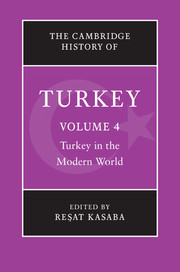Book contents
- Frontmatter
- 1 Introduction
- PART I OTTOMAN BACKGROUND AND TRANSITION
- PART II REPUBLIC OF TURKEY
- 7 Migration and Turkey: the dynamics of state, society and politics
- 8 The migration story of Turks in Germany: from the beginning to the end
- 9 Politics and political parties in Republican Turkey
- 10 Economic change in twentieth-century Turkey: is the glass more than half full?
- 11 Ideology, context and interest: the Turkish military
- 12 Kurds and the Turkish State
- 13 Islam and politics in contemporary Turkey
- 14 Sufism and Islamic groups in contemporary Turkey
- 15 Contestation and collaboration: women’s struggles for empowerment in Turkey
- 16 Art and architecture in modern Turkey: the Republican period
- 17 The novel in Turkish: narrative tradition to Nobel prize
- 18 A brief history of modern Istanbul
- Select bibliography
- Index
- References
8 - The migration story of Turks in Germany: from the beginning to the end
from PART II - REPUBLIC OF TURKEY
Published online by Cambridge University Press: 28 November 2009
- Frontmatter
- 1 Introduction
- PART I OTTOMAN BACKGROUND AND TRANSITION
- PART II REPUBLIC OF TURKEY
- 7 Migration and Turkey: the dynamics of state, society and politics
- 8 The migration story of Turks in Germany: from the beginning to the end
- 9 Politics and political parties in Republican Turkey
- 10 Economic change in twentieth-century Turkey: is the glass more than half full?
- 11 Ideology, context and interest: the Turkish military
- 12 Kurds and the Turkish State
- 13 Islam and politics in contemporary Turkey
- 14 Sufism and Islamic groups in contemporary Turkey
- 15 Contestation and collaboration: women’s struggles for empowerment in Turkey
- 16 Art and architecture in modern Turkey: the Republican period
- 17 The novel in Turkish: narrative tradition to Nobel prize
- 18 A brief history of modern Istanbul
- Select bibliography
- Index
- References
Summary
The beginning
Like every story, the history of Turkish migration to Germany has a beginning and an end. 1963 marked the beginning as the first Turkish workers left their country for Germany, expecting to work hard, earn money, and then return home to build a good life. The end comes some forty years later, after the turn of the millennium, at a time when Europe is in the process of building a Union and Turkey is negotiating the terms of membership in that Union. This chapter retells that short history, which saw the establishment of Turkish populations in Germany, as well as in the larger geography of Europe, amid much heated debate on migration and culture and integration within and without Europe.
In the official version of migration history, Turkish migration to Europe begins in 1963, with the signing of bilateral agreements with Germany (and various European states), creating what are called the guestworker programmes. The official story is an exercise in statistics, registering who entered and left and keeping account of the difference: the net migration. Across Europe, the protagonist in this migration history is the categorical international migrant worker, primarily taking part in an institutionalised worker exchange. Labour migration occurred between countries at the industrialised centre of Europe (Austria, Belgium, Germany, France, the Netherlands, Sweden and Switzerland) and the countries at Europe’s southern periphery (not only Turkey, but also Italy, Spain, Portugal, Greece, the former Yugoslavia, Algeria and Morocco), with the movement of workers from the latter to the former, from periphery to the centre.
- Type
- Chapter
- Information
- The Cambridge History of Turkey , pp. 199 - 225Publisher: Cambridge University PressPrint publication year: 2008
References
- 1
- Cited by

